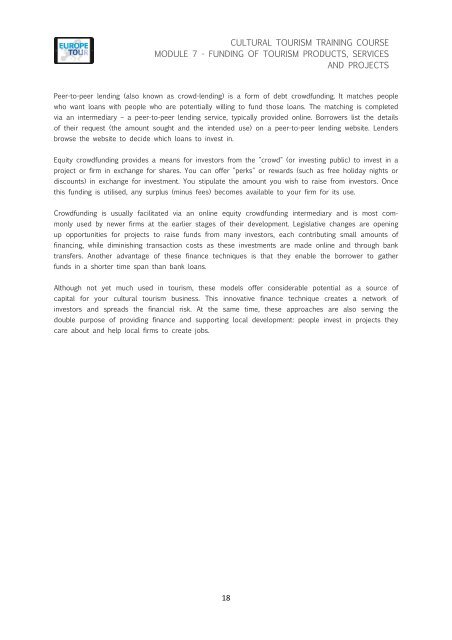Module_7_Funding
Create successful ePaper yourself
Turn your PDF publications into a flip-book with our unique Google optimized e-Paper software.
CULTURAL TOURISM TRAINING COURSE<br />
MODULE 7 - FUNDING OF TOURISM PRODUCTS, SERVICES<br />
AND PROJECTS<br />
Peer-to-peer lending (also known as crowd-lending) is a form of debt crowdfunding. It matches people<br />
who want loans with people who are potentially willing to fund those loans. The matching is completed<br />
via an intermediary – a peer-to-peer lending service, typically provided online. Borrowers list the details<br />
of their request (the amount sought and the intended use) on a peer-to-peer lending website. Lenders<br />
browse the website to decide which loans to invest in.<br />
Equity crowdfunding provides a means for investors from the "crowd" (or investing public) to invest in a<br />
project or firm in exchange for shares. You can offer "perks" or rewards (such as free holiday nights or<br />
discounts) in exchange for investment. You stipulate the amount you wish to raise from investors. Once<br />
this funding is utilised, any surplus (minus fees) becomes available to your firm for its use.<br />
Crowdfunding is usually facilitated via an online equity crowdfunding intermediary and is most commonly<br />
used by newer firms at the earlier stages of their development. Legislative changes are opening<br />
up opportunities for projects to raise funds from many investors, each contributing small amounts of<br />
financing, while diminishing transaction costs as these investments are made online and through bank<br />
transfers. Another advantage of these finance techniques is that they enable the borrower to gather<br />
funds in a shorter time span than bank loans.<br />
Although not yet much used in tourism, these models offer considerable potential as a source of<br />
capital for your cultural tourism business. This innovative finance technique creates a network of<br />
investors and spreads the financial risk. At the same time, these approaches are also serving the<br />
double purpose of providing finance and supporting local development: people invest in projects they<br />
care about and help local firms to create jobs.<br />
18

















